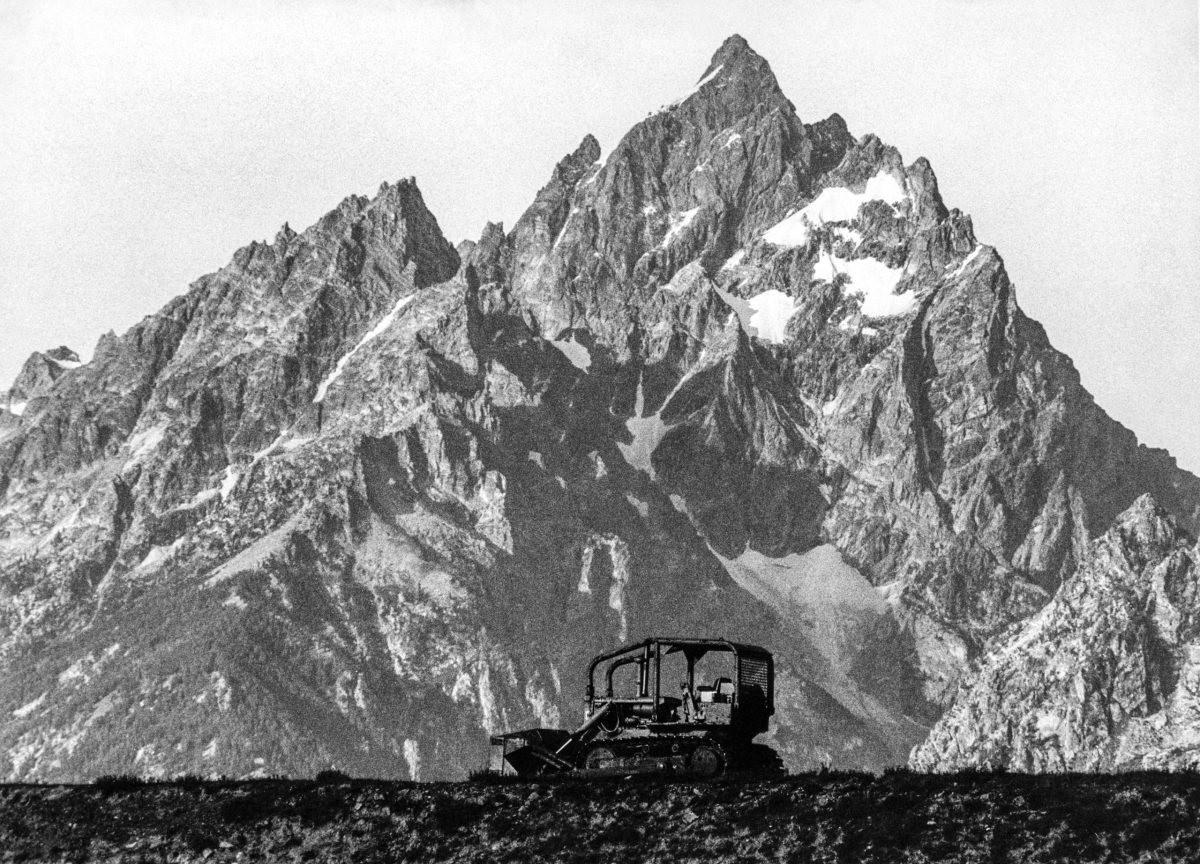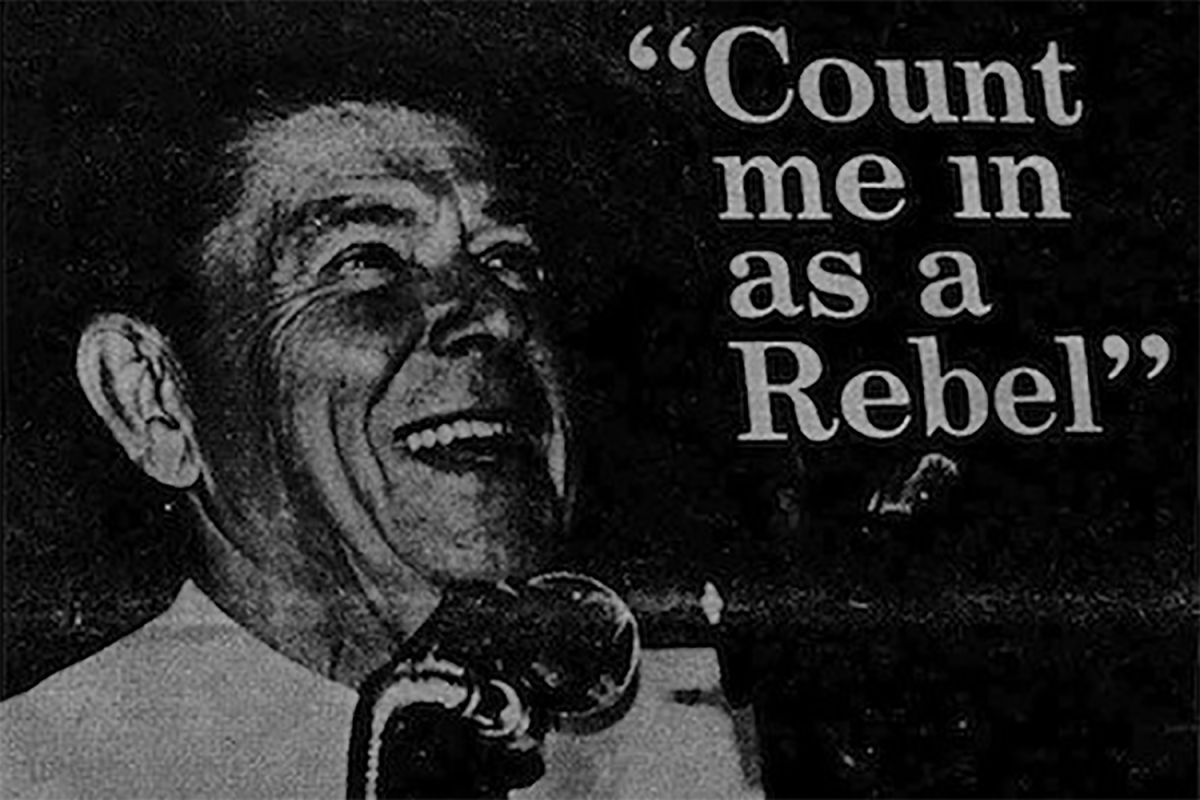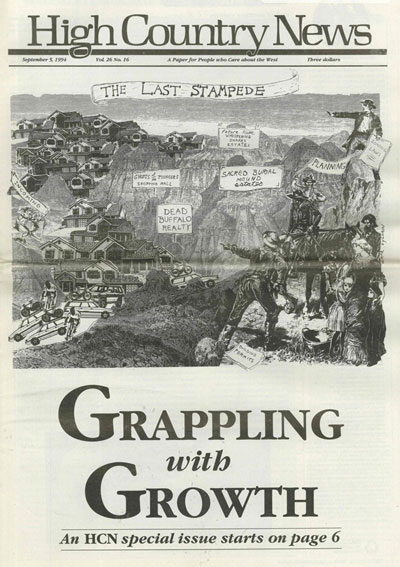Across the Decades – 1970 – 2020
If journalism is the first draft of history, then High Country News has been busily assembling the chapters of the comprehensive tome that will shape how we view the last 50 years of life in the Western United States.
And what a half-century it has been. From the Great Plains to the Pacific Coast, from the desert Southwest to the wilds of Alaska, HCN’s writers and editors have chronicled the ever-changing interactions between the human and non-human environment, as ever more people have flooded into the region, putting pressure on its stunning geography as never before. With dogged reporting and fresh perspectives, the nonprofit publication has shed light on landscapes and communities largely overlooked by other media outlets, driving conversation and prodding progress.
From its inception in 1970 as a rare environmental voice in the region, to its increasingly nuanced coverage of the social, political and economic dynamics of the country’s most rapidly growing and diverse population, High Country News has, story by story, unveiled the real West. It has illuminated a place of not only beauty, but of contradictions and conflicts that test our understanding of this country and the world.
What follows are some of the highlights from each of HCN’s five decades of work, and a look at what may lie ahead.
-
1970s
Next decade ↓ -

Though called a “firebrand,” Bell was also reverent about the wonders of the natural world. “My lot has been cast with the simple wonders of the world. You cannot buy the light flashing from a rainbow’s side in limpid waters. There is no price on the hoot of an owl from dusky woods at eventide. You can only experience a coyote by hearing his howl.” August 28, 1970.
THE BIRTH OF A WESTERN INSTITUTION
In 1969, Tom Bell, a fifth-generation Wyoming rancher, wildlife biologist and veteran of World War II, bought Camping News Weekly, a struggling newspaper in Lander, Wyoming. He turned it into a platform for conservation-minded reporting for “people who care about the West.”
A year later, he renamed the publication High Country News and committed it to covering the many threats posed to the West’s public lands, water and wildlife at the hands of politicians, corporations, developers and even some of his fellow ranchers.
Despite Bell’s passion, High Country News lost money. Bell and his wife, Tommy, took out a second mortgage on their ranch and sold their few uranium claims to keep the publication alive. Still, in 1973, Bell wrote to his readers, announcing that the gig was up: “We’ve done our best, but it was not enough.” Readers immediately responded with enough donations to keep High Country News going.
“Each day the letters come pouring in and you alternate between humbly crying and joyfully cheering,” Bell wrote. “People whom we have never met except through the pages of a little paper write us as they would a long-lost friend. Somehow we have created another bond between people across a far-flung land.” -

In an era of bi-partisan cooperation, Congress passed wilderness bills protecting tens of millions of acres in the West.
SOUNDING THE ALARM
Bell retired in 1974, burned out and worried about the fate of the world. A talented cadre of young conservation-minded journalists, including Joan Nice and Bruce Hamilton, Marjane Ambler, Dan Whipple and Geoff O’Gara, ran the magazine for the rest of the decade, expanding its coverage of natural resource issues and communities.
HCN’s reporting about the environmental damage caused by mining, and the industry’s entrenched political power, helped pass a national mining reclamation bill. The cleanup legislation was a part of a wave of lawmaking during the decade, driven by rising environmental consciousness designed to protect water, air, land and wildlife.
But a national shortage of crude oil soon set off oil shale mining across Colorado, Utah and Wyoming. The federally subsidized effort collapsed under falling prices and skyrocketing costs in the 1980s, a classic Western case of boom and bust, but HCN chronicled the “oil shale fever” while it lasted. -
NEW LEADERSHIP
By the 1980s, HCN was operating as a nonprofit, with a circulation of 4,000 stalwart subscribers. Subscriptions and donations paid the bills, but the organization still ran on a shoestring. The staff, like Bell before them, ran themselves ragged covering the backlash to environmental regulations led by James Watt, President Ronald Reagan’s Interior Department secretary, a longtime advocate of unfettered mining, grazing, drilling and logging on public lands. HCN would need new leadership to write the next chapter.
In 1983, HCN’s board of directors selected Ed and Betsy Marston to run the newspaper out of Paonia, Colorado. The Marstons, New York City transplants, saw the region’s complex issues with fresh eyes. Ed, a former physics professor, served as publisher, and Betsy, a former TV journalist, as editor. The Marstons would run the organization for nearly two decades.
Ronald Reagan supported the Sagebrush Rebels’ cause, and they supported him. This appeared in High Country News in 1980.
-
WESTERN WATER, EXPLAINED
In 1983, following a record year of snowmelt and spring rains, High Country News made waves with the exclusive inside story of How Lake Powell nearly broke free from Glen Canyon Dam.
In 1986, the paper published “Western Water Made Simple,” a four-part series on issues facing the West’s major watersheds — the Colorado, Columbia, Missouri and Rio Grande. The series won the prestigious George Polk Award for environmental reporting.
Other stories that decade covered the efforts of conservationists and Congress to protect more wilderness, and the logging industry’s increased cutting of old-growth trees in national forests. HCN investigated the agency bureaucrats beholden to the industry — and the activists fighting the destruction.
-

THE LORDS OF YESTERDAY
Over the course of the 1990s, the Marstons and their small staff covered the decline of the West’s “Big Three” extractive industries — logging, ranching and mining. But even as conservationists cheered the Big Three’s demise, a host of new challenges rose up in their place. The Marstons chronicled everything.
Regulations designed to protect the spotted owl put the final nail in the coffin of old-growth logging in the Pacific Northwest. But as mills closed and timber towns emptied out, they left behind forests choked with young trees of little use to wildlife and increasingly vulnerable to wildfire. HCN covered the struggle to balance logging with wildlife protection — efforts such as the 1993 Northwest Forest Plan and the work of the Quincy Library Group in California.
Similarly, environmentalists waged a massive campaign against politically powerful ranchers, seeking to rein in the practice of overgrazing livestock in fragile Western ecosystems. But Ed Marston sought out examples of collaboration between ranchers and environmentalists, profiling ranchers like Doc and Connie Hatfield of Brothers, Oregon, who pioneered grazing practices that restored the land.
When fights sprang up over the cleanup of contaminated mine sites around the West, HCN brought together a gold-mining mogul and an environmental activist to work on a compromise. -

NEW THREATS, NEW SOLUTIONS
While old industries withered, housing development sparked a new explosion. The population of the West soared, real estate boomed, and resort towns like Aspen and Vail, Colorado, became recreational empires. “The population movement is of such a scale that it carries an inherent threat,” HCN editors wrote in 1993: “that the West will become another homogenized piece of America.”
Success in this new era relied on breathtaking scenery and the leap to tourism and recreation, but Congress had lost its appetite for protecting the West’s wild places. In response, Interior Secretary Bruce Babbitt convinced President Bill Clinton to take matters into his own hands.
With a stroke of a pen, Clinton protected 1.7 million acres of federal lands in Southern Utah as the Grand Staircase-Escalante National Monument. Using the 1906 Antiquities Act, Clinton designated 19 national monuments and conservation areas during his time in office. And as always, HCN was there to tell the story, exploring what the new monuments meant for the people in nearby communities. -
A NEW GENERATION
In 2002, after nearly two decades at the helm, the Marstons decided it was time for new leadership. Longtime staffer Paul Larmer became publisher, and Greg Hanscom took over as editor. Together with the staff, they turned the black-and-white tabloid into a full-color magazine and broke important new ground while continuing to chronicle the region’s troubled relationship with extractive industries.
The 2000s brought an unprecedented oil and gas boom, spurred by $100/barrel oil prices and new hydro-fracking technology that enabled producers to tap new reservoirs of hydrocarbons, particularly in Wyoming, Colorado and New Mexico. Industry-friendly appointees in the George W. Bush administration opened the doors to new development on public lands.
Labor camps sprang up overnight and boomtowns became hotbeds for easy money, violence and drugs. Senior Editor Ray Ring published a groundbreaking investigative piece about the boom’s human toll. Between 2000 and 2006, 89 workers died in the West’s energy fields. Ring acknowledged each by name and described how they perished.
Despite sophisticated computers on some rigs, it is ultimately up to the drill operator to take the pulse of the rig and to watch the backs of his fellow roughnecks. “Whatever is going on, we always just move slow,” says one. JT Thomas
-
A WARMER, AND WIDER, WEST
As HCN chronicled the new energy boom, the evidence mounted that fossil-fuel-driven climate change was already impacting the West, bringing increased wildfire, forest die-off and drought. HCN Contributing Editor Michelle Nijhuis wrote the groundbreaking climate series “Hot Times” years in advance of mainstream media coverage and received the 2006 Sullivan Award for Excellence in Science Journalism.
The magazine also began to expand its coverage of social issues, exploring immigration and issues along the U.S. Mexico border, as well as stories about drug addiction and gang violence, and their connections to Western communities. In 2006, HCN published its first piece of fiction, “The Tamarisk Hunter,” set in the desert Southwest in 2030. The author, Paolo Bacigalupi, who served as HCN’s digital editor, went on to become an internationally acclaimed science fiction writer.
High Country News survived the Great Recession of 2007-2008 with the help of its loyal readers and began a robust period of growth, both in readership and as a nonprofit organization.
Stan Shaw
-

An armed member of the Oath Keepers stands guard at the Sugar Pine Mine in Josephine County, Oregon, in an operation the Oath Keepers said was aimed at defending the constitutional rights of two miners. Jim Urquhart/Reuters
NEW SAGEBRUSH REBELLIONS
The 2010s were marked by growing tensions across the West, as Sagebrush Rebels rose up against the policies of President Barack Obama, while a diverse coalition of activists began to come together to stop energy development and slow climate change.
Right-wing ideologies, galvanized by the election of the first African American president, coalesced in 2014 in an armed standoff with Cliven Bundy, a Nevada rancher who had refused to pay over $1 million in grazing fees for use of federal lands. Two years later, an armed militia led by Bundy’s son Ammon seized the Malheur National Wildlife Refuge headquarters in Oregon, demanding that public lands managed by the federal government be turned over to states. The conflict lasted 40 days and resulted in the death of one militia member and numerous arrests.
Meanwhile, another uprising was in progress. Climate and social justice activists found common ground at Standing Rock in October 2016, when Native American tribes led a protest against the Dakota Access Pipeline after construction threatened Native water sources and sacred burial sites near the Standing Rock Indian Reservation. The violent response to the protesters gained extensive media attention, including incisive, on-the-ground coverage in High Country News. -

Kyle Mateo, Marisa Pelletier, and Rick Buckman Coe (from left) pose for a photograph in the Oceti Sakowin camp on the edge of the Standing Rock Sioux Reservation in November. Pelletier is Ojibwe. The three traveled from Vancouver, British Columbia, to oppose the Dakota Access oil pipeline. Terray Sylvester
FRACTURE LINES
The election of President Donald Trump in 2016 laid bare the deep divides that existed across the country — especially in the West.
In one of his last acts in office, President Obama had established the 1.3 million-acre Bears Ears National Monument in Utah, protecting a wealth of historic, cultural and natural resources. The designation was accomplished with the cooperation of tribes but was staunchly opposed by some locals and right-wing politicians. In December 2017, a year after Obama created the monument, Trump reduced its size by 85% and cut Clinton’s Grand Staircase Escalante National Monument nearly in half.
Trump, who had used illegal immigration as the signature issue of his campaign, proposed to build a wall to deter immigration along the U.S.-Mexico border. High Country News reporters delved deep into the Borderlands, revealing the severed connections between once-united communities, and chronicling citizens pulling together to fight back against vigilante groups patrolling the region. -
2020s
-
LESSONS FROM THE FIRST 50 YEARS
Fifty years in, it’s tempting to think that little has changed since Tom Bell transformed a weekly aimed at Wyoming campers into a scrappy environmental tabloid, thereby creating High Country News. Ranchers and Sagebrush Rebels seem as entrenched as ever. Ammon Bundy, who was cleared of all charges in the Malheur standoff, has been traveling the West, fanning the flames of anti-government sentiment. President Trump has put a former energy industry lobbyist in charge of the Department of the Interior, and longtime anti-public-lands activist William Perry Pendley is running the BLM. It’s Reagan-Watt all over again.
But if HCN has proven one thing over the years, it’s that the West is far more complex than it appears on the surface. While differences and disagreements flare, and fights inevitably make the headlines, there is a bond that unites the diverse people who care about this region and want to help it live up to its potential.
In Western towns and cities, people are marching against climate change and police brutality against Black Americans. Indigenous nations have increasingly taken leadership roles in movements for ecological restoration, climate sanity and racial justice. A new, diverse generation of Westerners is bringing a fresh vision and an insistence on rapid progress. Change is in the air.
Zoë van Dijk for High Country News
-

HCN‘s 52.9 issue celebrates the legacy of Tom Bell and the 50-year history of High Country News, even as a path forward is charted.
THE NEXT CHAPTER
In March of 2020, former HCN Editor Greg Hanscom took the helm as publisher after 14 years of working for news organizations on both coasts. Much remains familiar: HCN is still committed to clear-eyed journalism about the West in all of its complexity. It is still staffed by some of the most passionate people in the business, united by their belief in the power of journalism and their deep love for the West. And it is still funded by its readers, who provide 75% of the publication’s revenue through their subscription dues and donations.
But other things have changed: While HCN still maintains a headquarters in Paonia, where the circulation, customer service, business and production teams are based, much of the staff has dispersed across the region. HCN now has employees from Tucson, Arizona, to Moscow, Idaho, and from Seattle, Washington, to Norman, Oklahoma.
This dispersal has allowed HCN to expand its scope beyond the Intermountain West to include deeper coverage of coastal states and Indian Country. It has allowed the organization to build a more racially diverse staff, including a dedicated Indigenous Affairs desk. And it allows the organization to attract top talent, including a growing product development team that will rebuild HCN’s website and overhaul its digital marketing strategy.
“The West has changed in the last half-century, and High Country News has changed,” Hanscom says. “But HCN’s relationship with its readers, who have built this institution, and share our love of this region, remain at the heart of it all.”

